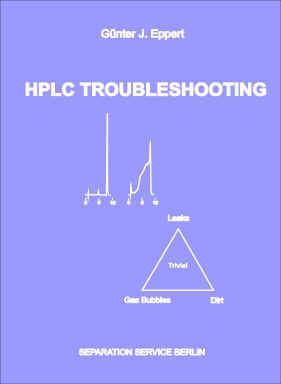Eppert,
Günter J.
Leitfaden ausgewählter Trennmethoden
(Only from SEPSERV)
88 Pages, 60 Pictures, 15 Tables, Paperback
Deutscher Verlag für Grundstoffindustrie, Leipzig/Stuttgart 1994
Price: € 10.00
From the content
Extraction – Multiplicative
distribution – Liquid chromatography – Thin layer chromatography – Gas
chromatography – Supercritical fluid chromatography – Coupling of chromatographic
and spectrometric methods – Membrane separations – Elektrophoresis –
Field flow fractionation
Eppert,
Günter J.
Flüssigchromatographie
HPLC
– Theorie und Praxis
(Available
from book shops or from SEPSERV)
3.,
Revised and enlarged edition
Verlag Vieweg, Wiesbaden 1997
(Distribution: Springer-Verlag, Heidelberg)
323
pages, 112 pictures, 31 tables, and 62 control exercises with
solutions
€
49.95
ISBN
978-540-67022-3
From the content
General theoretical principles – The
chromatographic packings – The separation column –
The eluent – Fixed phase and ion exchange chromatography – Equipment –
Programmed elution – Analytical chromatography – Thin layer chromatography as a
pilot technique of column chromatography – Purchasing
a HPLC instrument – Does my instrument work reliably? – Frontal and displacement
chromatography – Control exercises and solutions – Literature –
Working assistances – Index
|
Eppert,
Günter J.
HPLC Troubleshooting
Textbook
and Training Manual for Chromatographer
with
32 Exercises (Text in English and German)
(Available
from book shops or from SEPSERV.
Out of
print!)
1.
Edition
SEPSERV
Separation Service, Berlin 2003
145
Pages,
36 Figures, 13 Tables
Price:
€ 25.00
ISBN
978-3-00-010808-2
|

|

|
|
Vorwort
Dieses Buch entstand aus der Praxis und ist für
die Praxis bestimmt. Aufbereitet wurde Material, das ich in einer großen
Zahl von Schulungen innerhalb und außerhalb der Firma SEPSERV
verwendet habe. Probleme vieler Kunden, die sich bei Schwierigkeiten an
uns wandten, und nicht zuletzt unsere mehr als 25jährigen Erfahrungen
mit diversen Problemen und HPLC-Apparaturen flossen ein.
„Schnell orientieren, Fehler erfolgreich
finden und vermeiden“, ist das Anliegen meines Buches. Parallel
zum Text wird dem Leser der jeweilige Sachverhalt durch Zeichnungen und
Tafeln aufbereitet.
Nicht zuletzt sollte der Leser nach gründlicher
Lektüre des Buches zu einer realistischen Trennsäulenbeurteilung
in der Lage sein und nicht, wie so oft, für jeden apparativen oder
sonstigen Fehler sofort seine Trennsäule verantwortlich machen.
Auch die Anwendung englumiger
Trennsäulen
mit 3 und 2 mm Innendurchmesser wurde herausgestellt, denn es gibt
heute keinen plausiblen Grund, auf ihre Vorzüge bei der täglichen
Arbeit zu verzichten.
Erfolgreiches Troubleshooting setzt bestimmte
Kenntnisse in der Chromatographie voraus. Zwecks Einführung oder
Vertiefung wird deshalb im Text gelegentlich auf
mein Buch „Flüssigchromatographie, HPLC – Theorie und
Praxis“ Bezug genommen.
Die vorliegende Arbeit ist zweisprachig angelegt.
Nur in den Abbildungen wurde, der besseren Übersicht wegen, ausschließlich
englischer Text verwendet, wobei die graphischen Darstellungen für sich
selbst sprechen sollen.
An dieser Stelle gilt
mein Dank allen unseren Kunden, die Probleme beisteuerten, meinen
Mitarbeitern und nicht zuletzt meiner Frau, die mit Verständnis und
vielen Hinweisen zum Gelingen des Buches beitrugen.
Es bleibt zu hoffen,
dass der Leser nach Studium des Buches
das Leistungsvermögen seiner HPLC-Anlage bei der Lösung
praktischer Probleme wesentlich besser nutzen kann.
G.
J. Eppert
|
Preface
This book is a result of
practical experience and is intended to assist in the reader’s
practical work. The material has been prepared from that of numerous
training courses which I have conducted at SEPSERV and elsewhere. Many
difficulties that clients have brought to our attention, as well as our
own experience of more than twenty-five years with various issues and
HPLC equipment have provided ample input.
My
book focuses on the individual’s “quickly grasping a situation,
then identifying and avoiding the problems”. Illustrations and
tables that accompany the running text help provide the reader with a
comprehensive overview of the material.
One
ultimate goal after close study of this book is that the reader is
capable of actually judging separation columns and not just
immediately blaming the separation column every time the
equipment fails or other trouble arises
Particular
emphasis has been placed on the use of narrow bore columns with
internal diameters of 3 and 2 mm, since there is no longer any reason
compelling enough to make us have to get along without the advantages of
using them in our daily work.
Successful
troubleshooting requires a certain amount of prior knowledge in
chromatography. Therefore, as an introduction and to broaden existing
knowledge on the subject, I occasionally refer to my book, “Flüssigchromatographie,
HPLC – Theorie und Praxis”.
Although this current
work is a bilingual publication, the Figures have been annotated only in
English for the sake of clarity. The graphics, on the other hand, should
speak for themselves.
I
would like to take this opportunity to thank all our clients who lent us
their problems, my colleagues, and last but certainly not least, my wife,
all of whom helped bring about this book’s success through their
understanding and many constructive comments.
Finally,
I do sincerely hope that the study of this book will assist the reader in
making significantly more efficient use of his HPLC system’s
capabilities in solving practical problems.
Berlin, February 2003
|
|
Inhalt |
| Abschnitte |
|
Vorwort |
|
|
Inhalt
|
|
1
|
Wo
sind Fehler möglich?
|
|
2
|
Fehler
systematisch lokalisieren
|
|
3
|
Das
Fehlerdreieck
|
|
3.1
|
Lecks
|
|
3.2
|
Luft
|
|
3.3
|
Schmutz
|
|
4
|
Die
Pumpe arbeitet nicht richtig
|
|
5
|
Die
HPLC-Trennsäule
|
|
5.1
|
Trennsäulen-Wartung
|
|
5.2
|
Welche
Säulen?
|
|
6
|
Verbindungselemente
|
|
7
|
Die
Rolle des Arbeitsdruckes
|
|
8
|
Die
Rolle der Temperatur
|
|
9
|
Wahl
des Probenlösungsmittels
|
|
10
|
Die
Störungen der Grundlinie
|
|
11
|
Peaktailing
|
|
12
|
Anwendung
von Puffern
|
|
13
|
Die
Gradienten-Verweilzeit
|
|
14
|
Retentionszeitänderungen
|
|
15
|
Negative
Peaks
|
|
16
|
Peaküberlappungen
|
|
17
|
Erarbeitung
einer Vorschrift
|
|
18
|
Übungen
|
|
19
|
Literatur
|
|
20
|
Sachregister
|
|
|
|
Abbildungen |
| 1 |
Grundausrüstung |
| 2 |
Systematische
Fehlerortung |
| 3 |
Das
Fehlerdreieck |
| 3.1.1 |
Wo
ist das Leck? |
| 3.2.1 |
Verhalten
von Luft |
| 3.2.2 |
Vakuumdegaser |
| 3.2.3 |
Gaslöslichkeiten
|
| 3.2.4 |
Luft
im Pumpenkopf |
| 3.2.5 |
Gasblasenmuster
|
| 3.3.1 |
Säulenschutz
|
| 3.3.2 |
Säulenverschlüsse |
| 3.3.3 |
Kartuschenhalter
|
| 4.1 |
Pumpenkopfaufbau
|
| 4.2 |
Ein
Ventil arbeitet nicht |
| 4.3 |
Peakflächen
und Retentionszeiten bei Flussänderungen |
| 6.1 |
Peakverbreiterung
durch Ver- bindungskapillaren |
| 6.2 |
Schlechte
Anschlüsse |
| 6.3 |
Verbindungssysteme
|
| 7.1 |
Viskosität
binärer Lösungsmittel |
| 7.2 |
Arbeitsdrücke
als Funktion der Methanol-Konzentration |
| 7.3 |
Optimaler
Arbeitsdruck |
| 8.1 |
Viskositäts-Temperaturverhalten
von Eluenten I |
| 8.2 |
Viskositäts-Temperaturverhalten
von Eluenten II |
| 9.1 |
Peakdeformation
nach Probeninjektion |
| 9.2 |
Beispiele
zur Peakdeformation |
| 10.1 |
UV-Spektren
einiger Lösungsmittel |
| 10.2 |
Geisterpeaks
|
| 11.1 |
Peaktailing
|
| 12.1 |
Ionenunterdrückung
|
| 12.2 |
Spektrumverschiebung
im UV durch pH-Wert-Änderung |
| 13.1 |
Informationen
zum Dwellvolumen |
| 13.2 |
Vergleich
von Soll- und Ist-
Gradienten |
| 13.3 |
Geräteprüfung
mittels Zehnstufengradienten |
| 13.4 |
Zehnstufengradienten
in Abhängigkeit Fluss/Dwellvolumen |
| 15.1 |
Entstehen
von Systempeaks |
| 16.1 |
Das
Ziehen der Tangente und des Lotes |
|
|
|
Tafeln |
|
1 |
Störungen
und Maßnahmen |
|
2 |
Wenn
der Druck nicht stimmt |
|
3 |
Was
muss ich über Trennsäulen wissen? |
|
4 |
Spülen
|
|
5 |
Kleinere
innere Durchmesser |
|
6 |
Grundtypen
von Umkehrphasen- Materialien |
|
7 |
Beachte
folgende Regeln |
|
8 |
Ursachen
für hohe Rauschpegel |
|
9 |
Gebräuchliche
Puffer |
|
10 |
pKa-Werte
organischer Säuren und Basen |
|
11 |
Verwendung
von Puffern für basische Stoffe |
|
12 |
Gründe
für Retentionszeitänderungen |
|
13 |
Kriterien
für gute Nacharbeitbarkeit |
|
|
Contents
|
| Sections |
|
|
Preface
|
|
|
Contents
|
|
1
|
Where
Can Trouble Arise?
|
|
2
|
Locate
Faults Systematically
|
|
3
|
The
Trouble Triangle
|
|
3.1
|
Leaks
|
|
3.2
|
Air
|
|
3.3
|
Dirt
|
|
4
|
Pump
Malfunction
|
|
5
|
The
HPLC-Column
|
|
5.1
|
Maintenance
of Separation Columns
|
|
5.2
|
Choosing
Columns
|
|
6
|
Connecting
Elements
|
|
7
|
The
Role of Working Pressure
|
|
8
|
The
Role of Temperature
|
|
9
|
Selection
of the Sample Solvent
|
|
10
|
Disturbances
of the Baseline
|
|
11
|
Peak
Tailing
|
|
12
|
Using
Buffers
|
|
13
|
The
Gradient Dwell Time
|
|
14
|
Alterating
Retention Times
|
|
15
|
Negative
Peaks
|
|
16
|
Overlapping
Peaks
|
|
17
|
Formulating
Instructions
|
|
18
|
Exercises
|
|
19
|
References
|
|
20
|
Index
|
|
|
|
Figures |
| 1
|
Basic
Equipment
|
| 2
|
Systematically
Localizing the Trouble
|
| 3
|
The
Trouble Triangle
|
| 3.1.1
|
Where
is the Leak?
|
| 3.2.1
|
Behaviour
of Air
|
| 3.2.2
|
Vacuum
Degasser
|
| 3.2.3
|
Solubility
of Gases
|
| 3.2.4
|
Air
in the Pump Head
|
| 3.2.5
|
Patterns
of Gas Bubbles
|
| 3.3.1
|
Column
Protection
|
| 3.3.2
|
Column
Closures
|
| 3.3.3
|
Cartridge
Holder
|
| 4.1
|
Pump
Head Construction
|
| 4.2
|
Valve
Malfunction
|
| 4.3
|
Peak
Areas and Retention Times at Flow Rate Alterations
|
| 6.1
|
Band
Spreading Caused by
Connecting Tubes
|
| 6.2
|
Mismatched
Fittings
|
| 6.3
|
Connecting
Systems
|
| 7.1
|
Viscosity
of Binary Solvents
|
| 7.2 |
Working
Pressure as Function of the Methanol Concentration |
| 7.3
|
Optimum
Working Pressure
|
| 8.1
|
Behaviour
of Viscosity with the Temperature of Eluents I
|
| 8.2
|
Behaviour
of Viscosity with the Temperature of Eluents II
|
| 9.1
|
Peak
Deformation After Sample Injection
|
| 9.2
|
Examples
for Peak Deformation
|
| 10.1
|
UV
Spectra of Some Solvents
|
| 10.2
|
Ghost
Peaks
|
| 11.1
|
Peak
Tailing
|
| 12.1 |
Ion
Suppression
|
| 12.2
|
Spectrum
Shift in the UV Range by Changing the pH Value
|
| 13.1
|
Information
about the Dwell Volume
|
| 13.2
|
Comparison
of Calculated Gradients to Actual Gradients
|
| 13.3
|
Equipment Test by Ten Step
Gradient |
| 13.4 |
Ten
Step Gradients Dependent on Flow Rate/Dwell Volume |
| 15.1 |
How
System Peaks Originate |
| 16.1 |
Drawing
Tangent and Perpendi-
cular |
|
|
|
Tables |
|
1 |
Trouble
and Precautions |
|
2 |
When
the Pressure is Incorrect |
|
3 |
What
Do I Have to Know about Separation Columns? |
|
4 |
Flushing
|
|
5 |
Smaller
Internal Diameters |
|
6 |
Basic
Types of Reversed Phase
Materials |
|
7 |
Take
Note of the Following Rules |
|
8 |
Reasons
for High Noise Levels |
|
9 |
Common
Buffers |
|
10 |
pKa-Values
of Organic Acids and
Bases |
|
11 |
Use
of Buffers for Basic Substan-
ces |
|
12 |
Reasons
for Shifts in Retention Time |
|
13 |
Criteria
for Good Reproducibility |
|
| |
Home
Survey
About
SEPSERV
Catalogue
HPLC Columns
Special
Columns
Environment
Food
Stuffs
Biochemistry
Clinical
Chemistry
.Pharmaceuticals
Chiralic
Analysis
Ion
Exchangers
OtherlSpeciallColumns
SelectivitylPacklTRIS
Ordering
|

